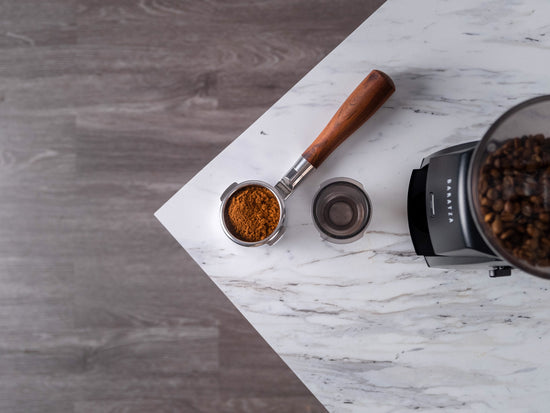Grind Consistency and Particle Size

There are an insurmountable amount of factors that can affect the quality of your espresso. When it comes to the grinder, let's look at some of the most important parameters we strive to control:
- The dose – the amount, as measured by weight, of ground coffee in the portafilter. While a traditional Italian single dose is 7 grams and a double is 14, a typical dose in a modern North American coffee shop will range from 18 to 20 grams or more. This difference in technique has as much to do with cultural preference as it does with differences in roasting style. At Clive, we typically dose 20 grams of coffee and we highly recommend at least starting with this recipe.
- The tamp pressure applied via the tamper by the barista to the ground coffee in the portafilter; 30 lbs. of force is often used as a rule of thumb when first starting out or when dialing in a new coffee. That said, consistency of technique and pressure is more important than the exact amount of force.
- The duration of the shot, i.e. the length of the time the water is passing through the ground coffee, under pressure, in the portafilter basket. Twenty-five to thirty seconds is often used as a target when dialing in a new coffee. We prefer the Verve Bronson French Roast blend to be pulled at 1-1.5oz in 28 seconds, which results in a rich mahogany color and syrupy consistency

So what are the key variables we are interested in for the ground coffee itself?
Particle Size
For espresso, we are talking about grinding coffee very fine, almost to the point where it could be considered a powder. When rubbed between the forefinger and thumb, the feeling of a pinch of espresso has been compared to that of powdered sugar. For our purposes, it isn’t necessary to get into the technical details about grind size, but it is clear that the ability to grind coffee very fine is fundamental to the making of espresso.
For example, pre-ground coffee can work for brewing methods such as drip or French press, but when used for espresso an inability to adjust grind fineness can result in a range of unsatisfying outcomes. If the grind is too coarse (like rough sand) coffee will not tamp properly, and a poorly extracted shot will rush through in less than 25 seconds. If the grind is too fine (like powdered sugar), the machine might even choke, and no shot will be extracted. Or it’s possible that a dark and oily shot will be produced, but might take much more than 30 seconds. Choking a machine is not good for it, and excessive choking can be potentially damaging to your machine. Depending on the kind of coffee used in these situations, you can expect unpleasant flavors ranging from the extreme end of sour to a very bitter taste.
Grind Consistency
Grind consistency and particle size impact other important variables, such as surface area and volume. It’s intuitively obvious that these variables will determine the way the water extracts flavor from the coffee.
Let’s think about what happens when we try to use a blade grinder for espresso. The blade grinder will result in a range of particle sizes, from a fine powder on the bottom to coarse particles on the top. When an espresso machine forces hot water through this coffee at 9 bar (or 130psi), water will flow too quickly over the coarse particles and too slowly through the fine particles. Some of the coffee will be over-extracted and some will be under-extracted, resulting in an unpleasant mix of the previously mentioned sour and bitter flavors.
Coffee that is very fine and very consistent in particle size will be much easier to work with through the espresso shot preparation process. It will be easier to find the ideal tamping pressure and much easier to dial in the shot duration. And the flavor extracted will be much more predictable because the heated and pressurized water will extract flavor(s) from the grounds in a more uniform and predictable way.
In summary, it's important to have a burr grinder for espresso. At Clive Coffee, we are constantly striving to offer our customers the highest-performing, most cost-effective, most beautiful assortment of grinders available. And in some cases, we’ve come up with a few gems that offer performance and value above and beyond what we’d normally expect. The key to our team being able to help find the right fit for you at the right time in your coffee journey will be a humble attitude as we explore your expectations and goals.
Continue on your journey of grinder knowledge with our What Makes a Grinder Great blog post.